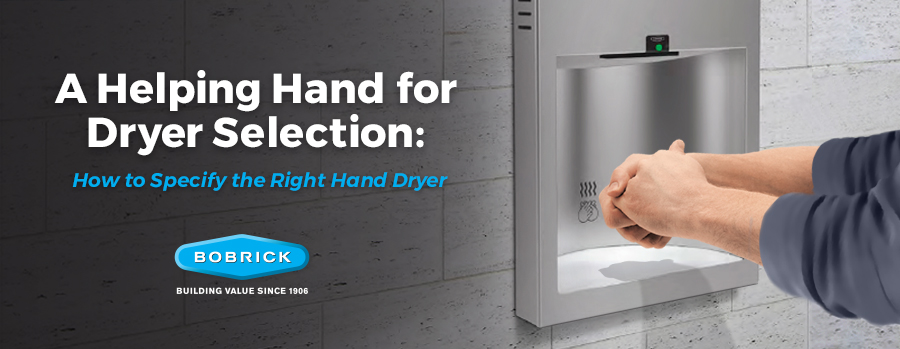AIA-Accredited Panel Discussion on Minimizing Disease Transmission in Public Restrooms
by Julie Wells | Jul 23, 2021 | News Releases






AIA-Accredited Panel Discussion on Minimizing Disease Transmission in Public Restrooms
HOW TO SPECIFY THE RIGHT HAND DRYER
Choosing the right hand dryer can facilitate a range of benefits for facilities. It can be the finishing touch that ties together a restroom’s high-end aesthetic, align with a facility’s goal of being ADA-complaint and help create a healthy, hygienic environment. A great hand dryer choice can also facilitate significant long-term cost savings for the owner while reducing the impact of the restroom on the environment.
Every building project—and every restroom—has unique needs. Your hand dryer specification should reflect those needs and provide added value to the owner, thereby strengthening your relationships and ensuring that the intent of your design endures.
CONSIDER OWNER, BUILDING TYPE & OCCUPANTS
Each building type has unique requirements and needs that hand dryers can support. Before specifying a hand dryer, ask yourself:
- What kind of building is it?
- Who will be using it?
- What kind of traffic must it serve?
- Which benefits can best serve these goals? (i.e. noise level, hygiene or design)
Thus, building type can help you form a baseline for your hand dryer specification. Consider the following building types and their requirements before choosing a hand dryer.
PRESTIGE BUILDINGS
Examples: Corporate headquarters, Class-A offices, iconic civic centers, major universities, concert halls, upscale properties, corporate headquarters
Characteristics: Clean, high-end design, hygiene and cleanliness
Critical Features
- High-end design: For prestige buildings, supporting the facility’s high-end aesthetic should be your top priority when choosing a hand dryer. Look for stainless steel finishes, clean forms, and, if budget and wall construction permits, recessed installation.
- Hygienic operation: One common drawback of many hand dryers is their tendency to splash water onto the restroom floor, wall or even the patron. Not only are these puddles unhygienic, but also they can create serious fall hazards. Look for models with design elements that absorb or catch excess water, which also can significantly reduce janitorial workload to support economical operation.
STANDARD USE BUILDINGS
Examples: Commercial office facilities, healthcare centers, hospitality projects, manufacturing plants, retail spaces
Characteristics: Moderate traffic, modest budgets, compliant objectives, pleasant environment
Critical Features
- Low noise: Since so many standard use buildings are places of work, learning and commerce, it’s critical that the hand dryers help maintain a pleasant, low-noise environment. Many popular hand dryer brands can operate as high as 86 measured decibels (dBA); consider models that operate at 72 dBA or lower to maintain a pleasant atmosphere conducive to productivity, learning and interaction.
- Accessibility compliance: Since so many standard use facilities—especially healthcare facilities—must serve people of very different ages and abilities, supporting accessible design objectives is critical. 2010 ADA Standards require that restroom accessories installed with leading edges between 27 inches and 80 inches above the floor must protrude no more than 4 inches maximum into a circulation path. Look for hand dryers that satisfy the 4-inch protrusion requirement.
“Nice to Have” Features
- Contemporary design: If budget permits, find a model with an aesthetically pleasing design that harmonizes with the restroom’s aesthetic. In fact, many hand dryers with distinctive designs and stainless steel finishes are available within many standard use clients’ desired price range.
HEAVY TRAFFIC BUILDINGS
Examples: K-12 schools, shopping malls, amusement parks, recreation facilities, transportation centers, airports, stadiums, restaurants
Characteristics: Periods of heavy traffic and usage, high facility operating costs
Critical Features:
- Low wattage: When it comes to energy costs, years of consistent, heavy traffic can add up. Seek out a low-wattage jet dryer that can support high traffic flow without driving up the facility’s energy costs. While some leading brands operate as high as 1.7 kW, Bobrick’s InstaDry™ Surface-Mounted Hand Dryer operates as low as 0.2 kW, facilitating to up to 80 percent savings on annual operating costs. Further, low wattage dryers can also achieve an effect of “accelerating savings”—the more they’re used, the more the facility saves. Finally, many heavy traffic facilities have lofty sustainability goals, and a low wattage dryer can help support that, too.
- Lifespan: Facility managers at high traffic facilities have enough to worry about—hand dryers breaking down on a regular basis shouldn’t be one of them. By investing in a hand dryer with a long lifespan, the replacement cycle is reduced and the facility spends less money and time replacing units.
“Nice to Have” Features
- High-end design: If budget allows it, a hand dryer with high-end aesthetics can help heavy traffic facilities project a high-end image.
Have a project that requires a smart hand dryer specification? Find Bobrick solutions in our Complete Hand Dryer Range brochure.
Review Your Options
Download Bobrick’s Complete Hand Dryer Range brochure to put these insights into action!
Download